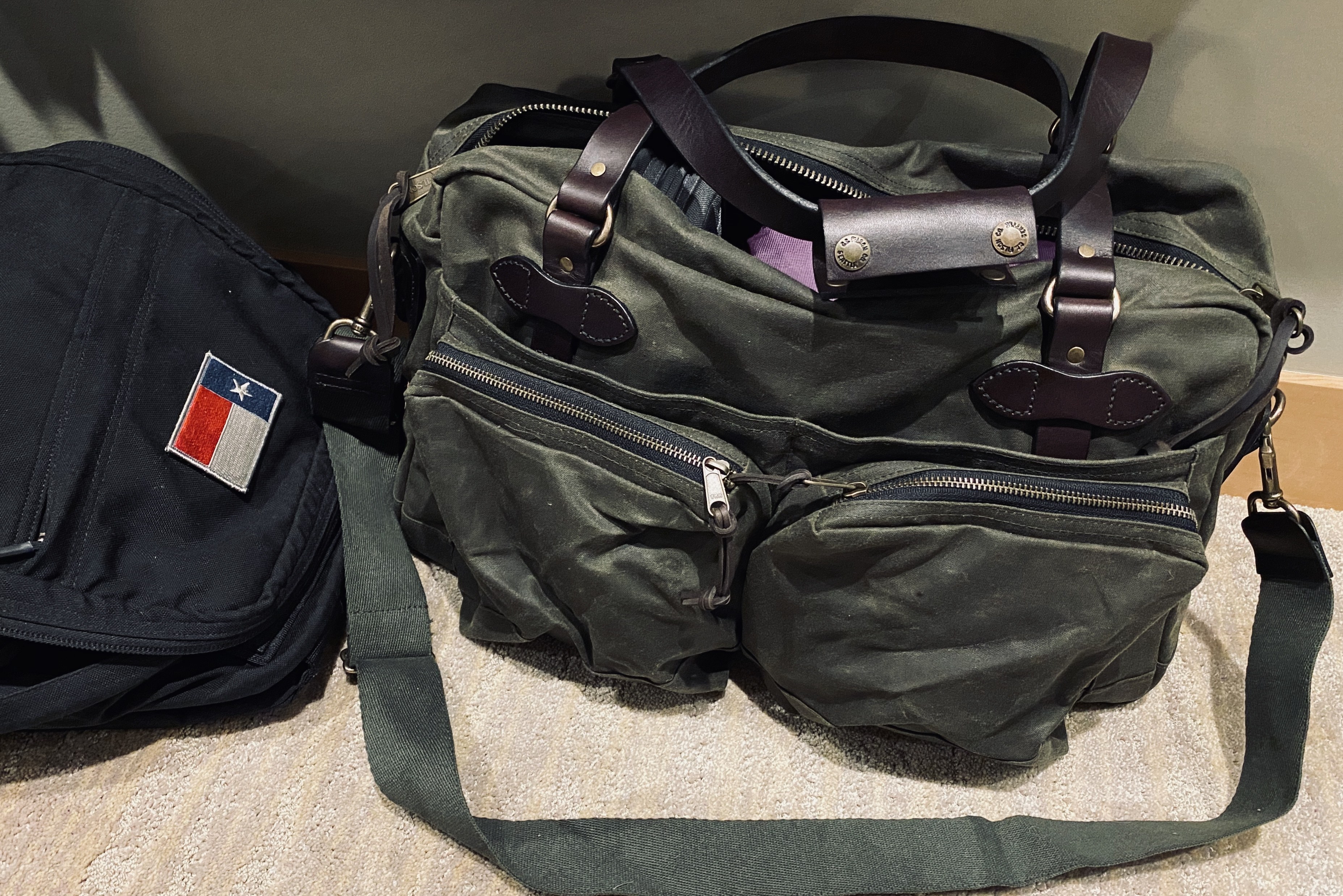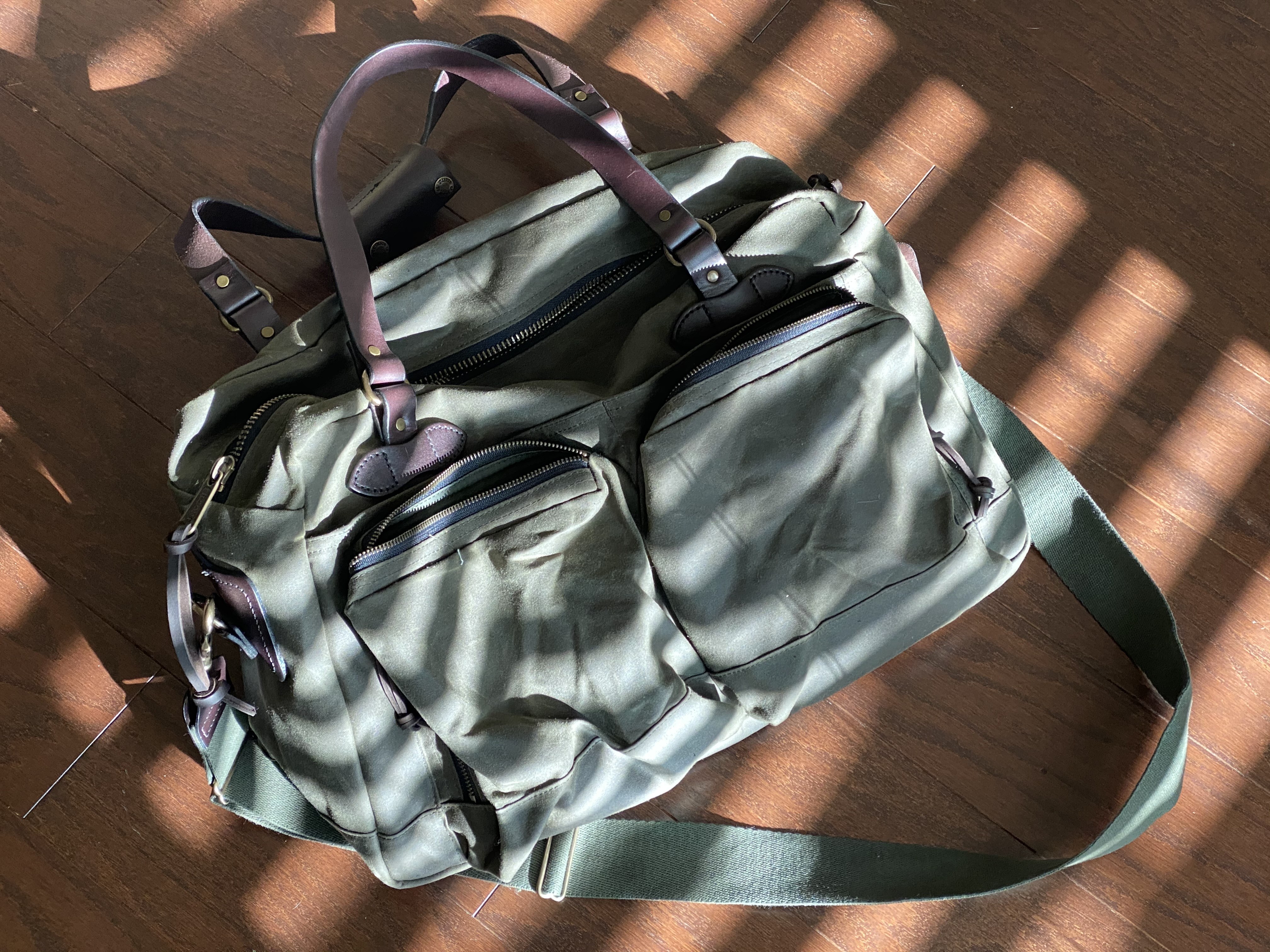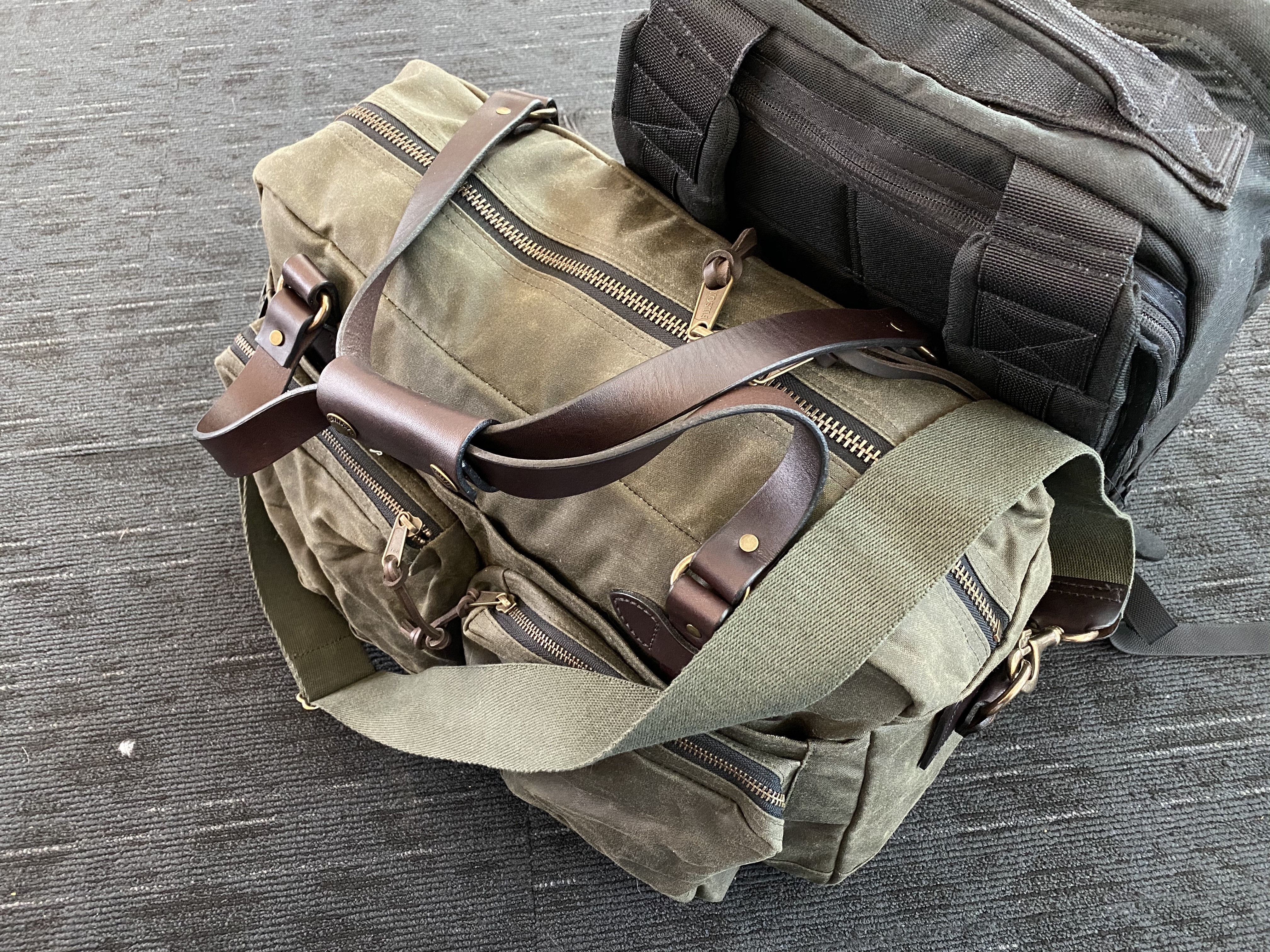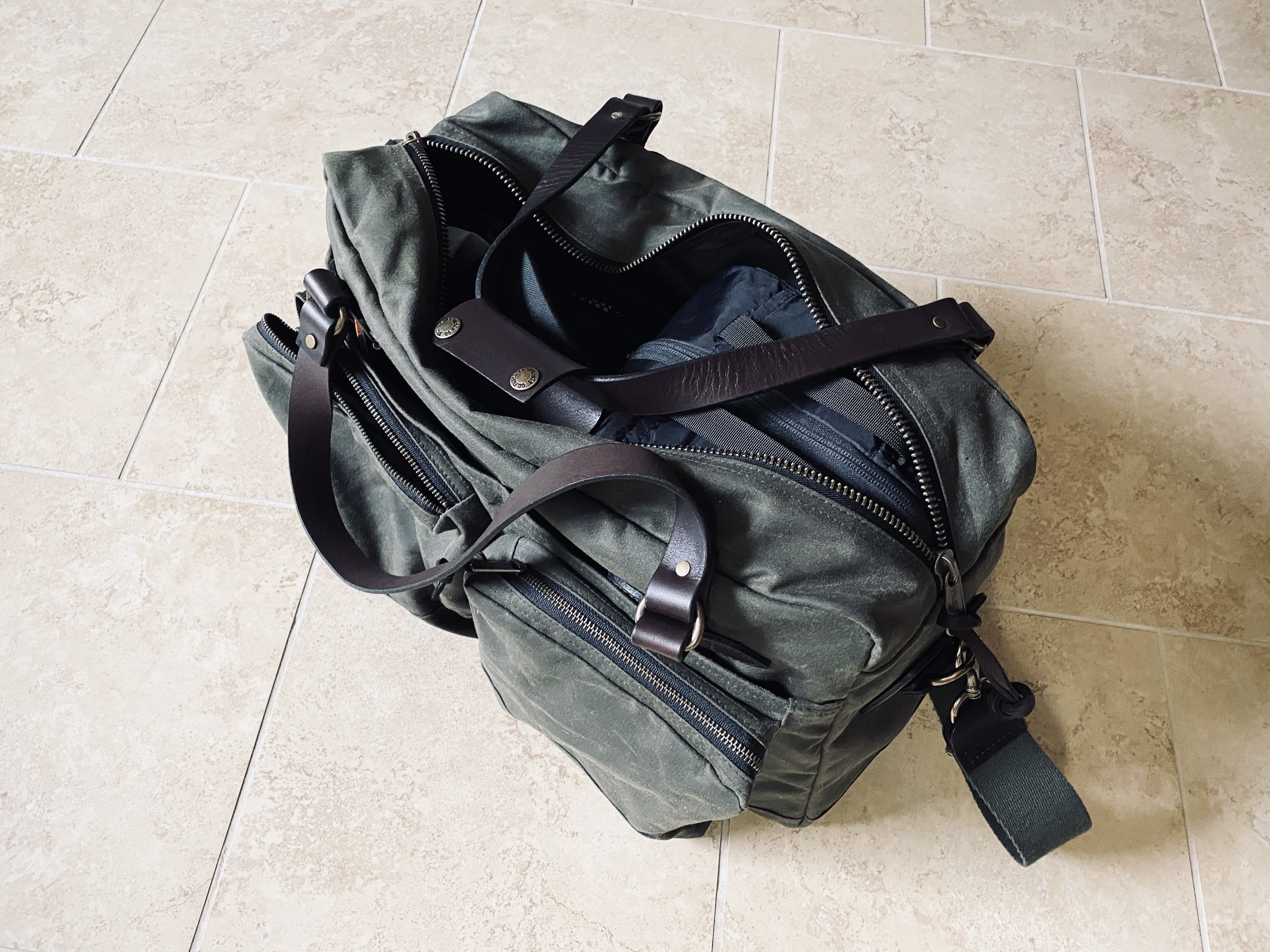Filson 48hr Duffle
Posted by admin on
I want to start by restating the fact that I am a huge believer in two things when it comes to travel: carrying just one bag is ideal, and backpacks are always better than anything else. But, in this post we are going to talk about a duffle bag, and a bag which also requires that I travel with two bags. There is a reason for this, and that is a topic for another post. That said, this bag is simply fantastic.
So having said all that, I want to talk about the expensive, beautiful, Filson 48hr Duffle. This bag is designed to carry everything you need for a weekend away, and thus it fits firmly in the weekender category. I have long wanted this bag, and picked one up while in Seattle over the holidays. The only problem I have with this bag is that I want to use it more than I can because every element of it speaks to me.
`

Tin Cloth
If you have spent any time looking at Filson products then you will likely have encountered the Tin Cloth fabric before. Generally speaking Filson makes its classic bags out of two fabrics: rugged twill (what the original briefcase uses), and Tin Cloth. Tin Cloth is a 12.5oz cotton fabric with an oil-wax finish on it. But that kind of down plays what Filson Tin Cloth really is.

Because Filson Tin Cloth is a bit legendary. It was designed as a material for very hard use in very hard conditions. If you needed something to stand up to wind, rain, and abrasion long before nylon was the rugged choice then you simply went with Tin Cloth. There’s not a ton of information on Tin Cloth out there, and specifically what makes it great. But from what I can see the weave is very tight and thus most things slide right off the fabric, and it is not at all snag prone. All of that plays to the abrasion resistance. Add to that the unique oil-wax finish and you get the weather resistance which Filson says will protect your gear from rain and snow. Sounds about right to me.
You can immediately see if something is an oil finished tin cloth garment or bag. The looks is distinctive — like a dirty waxed canvas look, almost unnatural in appearance. And completely lovable and desirable. The patina this material develops is amazing and yet so much of it disappear over time. I scuffed both front pockets when the bag took a wild dive onto asphalt. It looked scuffed to hell after that, but by the end of the trip, well it looks like how you see it in most of these pictures.
The one downside is that the finish can and will transfer to some garments when it touches it. Because of this, you will not want to have this rubbing hard in heat against delicate clothing. (The interior is a dry cover cloth, so no worries about the stuff inside the bag getting stained.) lastly, you need to recoat this fabric with oil-wax every year or so, and from what I hear it takes about an hour. Most people do not do this, to each their own — the bag comes with oil-wax just in case you want to keep the weather resistance in place.
All that said, I really love this fabric and finish — more so than any other material I have used or encountered. It is like a heritage dyneema fabric. Tough, rugged, smooth, with gorgeous patina.
Size
The stated size of the 48hr Duffle is 34.5L which means that it is a large bag. But then when I see it in person it doesn’t quite look that large and when you start packing it doesn’t feel that large. I can pack more in my 34L GR2 than I can in this bag. And it took me a bit to figure out why.
The main compartment is around 30L in size, and the two front zip pockets are about 2L in size. At first this was something hard to wrap my head around, because those front pockets don’t look that big. But in reality they are huge.
 Front pockets contain some minimal organization.
Front pockets contain some minimal organization.
So, this actually makes the bag interesting to pack, as you need to pack the large area with large items, while parsing out your smaller stuff in the front pockets if you want to efficiently use the space in the bag. Or you can simply fill the main compartment and have a smaller more nimble bag to tote around. But putting small stuff in pouches into the main compartment, will waste a bunch of space. Once I sorted that — all good.
Carry
There are two ways to carry this bag: shoulder or handles. (There is also a trolley strap, so if you do use rolling luggage there is a third way.) The shoulder strap is a rather vintage looking canvas strap and sticks well to your shoulder. I find that you need to carry this on one shoulder and not cross body.

The handles are very nice, made from Filson’s bridle leather, which makes all other leather feel weak in comparison. The handles are also cut long, so the bag hangs much lower when you carry it with those handles. Low enough that you could carry a briefcase on your shoulder, and the duffle in your hand and the two would not interfere with each other.
No matter how you carry this bag, when it is packed full it is heavy. Tiring to carry by hand or shoulder. Only a backpack could alleviate that strain, as it is something any bag of this size will encounter. I do think the shoulder strap is a bit short, and if you could carry this cross body things would be a bit lighter.
Then again, that’s not really what this bag is made for.
Airplanes

This bag easily meets the carryon requirements for the most stringent of airlines. And when you slide it into the overhead bin, it is comically small compared to the rolling bags most people carry on. You might be able to get away with this at your feet, but I have never tried it.
That said there is one downside to this: sometimes your bag gets smashed into the back of the overhead bin because people try to cram stuff in front of it. The best way I have found to avoid that is to it to the very front edge of the overhead bin so it looks like there is no extra room. Such is life, but on an airplane this bag is a most excellent carry on.
Style
I bought this bag because I loved the style of it. To me this bag is awesome looking and speaks a lot about who you are when you travel. It could be equally at home in a muddy field with your camping clothing, or packed neatly with a suit and dropped with the bell hop at a luxury hotel.
It’s not a backpack, as a backpack is a practical utilitarian way to travel. A backpack says I do it myself and I travel far and wide. This says: I don’t need to worry about carrying my gear, but my gear is ready for anything. I kind of love that bit of pretentiousness.
Some Tips

Here’s a few things I have figured out about this bag:
- GORUCK Packing Cubes fit in the main compartment extremely well. The 20L will take up most of the space with a little vertical space left. The 10L will take up about half of the bag. I tend to pack it with one 10L cube.
- Likewise Tom Bihn cubes work really well. This one will fit across the bottom of the bag quite nicely.
- There are two drop pockets at either end internally in the bag, these are fantastic for stashing your keys while traveling about. They are hard for people to see, and stuff doesn’t fall out of them easily.
- If the bag sits in hot sun, be aware that the protective oil-wax will get a little more transferable. But if there is a nasty blemish on the bag from it getting scuffed, a quick rub with your fingers while the bag is warm will take it right out.
Hope those help.
Overall
I am a huge fan of this bag. It has, and will remain, my go to bag when I am not just packing in a single small backpack. This doesn’t mean I think traveling with a large backpack is bad, but rather that it doesn’t suit the way I travel most of the time.
This bag is expensive, there is no way around it. But it also should last your entire life and is backed by one of the best warranties out there. Filson is known for this, and has been around for a very long time.
I cannot recommend this bag enough.




